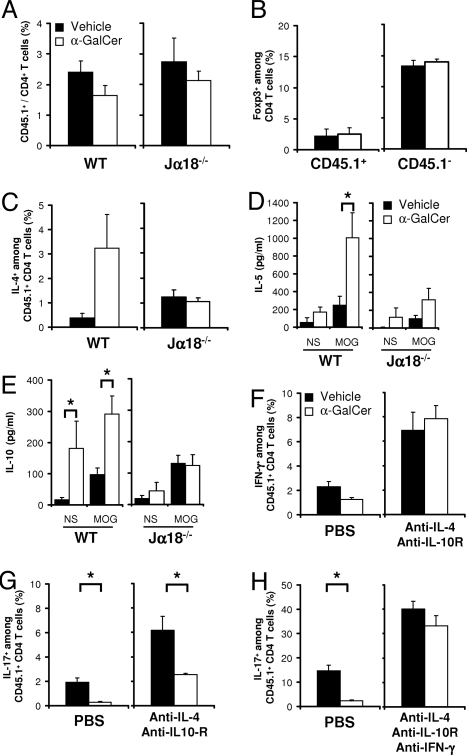Fig. 4.
Activation of iNKT cells by α-GalCer regulates the Th1 and Th17 responses by immune deviation and IL-10 production. By using the 2D2 transfer model described in Fig. 2, we assessed MOG-specific T-cell differentiation in the draining LNs of immunized C57BL/6 (WT) and Jα18−/− mice. Nine days after immunization, the intracellular IFN-γ, IL-17, IL-4, and IL-10 expression by CD45.1+TCRVα3.2+ CD4+ T cells was assessed in α-GalCer-treated mice (white bars; WT, n = 11; Jα18−/−, n = 4) and vehicle-treated mice (black bars; WT, n = 11; Jα18−/−, n = 4). (A) The effect of α-GalCer on the proportion of 2D2 CD45.1+TCRVα3.2+ CD4+ T cells in the draining LNs of recipient mice. (B) The frequency of Foxp3-positive cells among 2D2 CD45.1+TCRVα3.2+ and endogenous CD45.1− CD4+ T cells. (C) The proportion of IL-4-positive cells among 2D2 CD45.1+TCRVα3.2+ CD4+ T cells increased upon α-GalCer treatment of WT, but not Jα18−/− mice, indicating an enhanced Th2 differentiation in the presence of iNKT cells but not in their absence. (D and E) The release of IL-5 (D) and IL-10 (E) during the in vitro recall response was assessed in α-GalCer-treated mice (white bars; WT, n = 4; Jα18−/−, n = 4) or vehicle-treated mice (black bars; WT, n = 4; KO, n = 4). Cytokine release in unstimulated (NS) and MOG35–55-stimulated (100 μg/ml) cultures was measured after 72 h by Luminex immunoassay. (F–H) The role of IL-4, IL-10, and IFN-γ in regulating T-cell differentiation was evaluated in vivo by injecting neutralizing mAbs. Th1 (F) and Th17 (G-H) commitment was assessed in mice treated with vehicle or α-GalCer that had received mAbs neutralizing IL-4 and IL-10R (F and G), or IL-4, IL-10R, and IFN-γ (H). The single-cell analysis presents 3 separate experiments for the WT mice (A and C) and a single experiment for the Jα18−/− mice (A and C). For the cytokine secretion (D and E), 1 representative experiment of 2 is shown. The cytokine neutralization data (F–H) are from 1 experiment involving 4 individual mice per group for each neutralization protocol.

